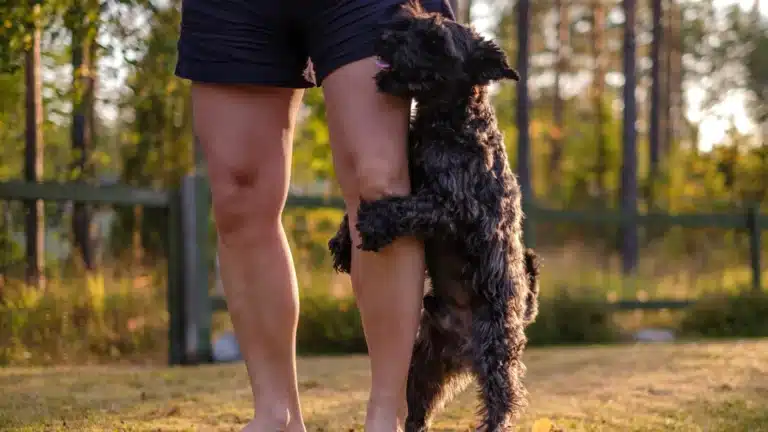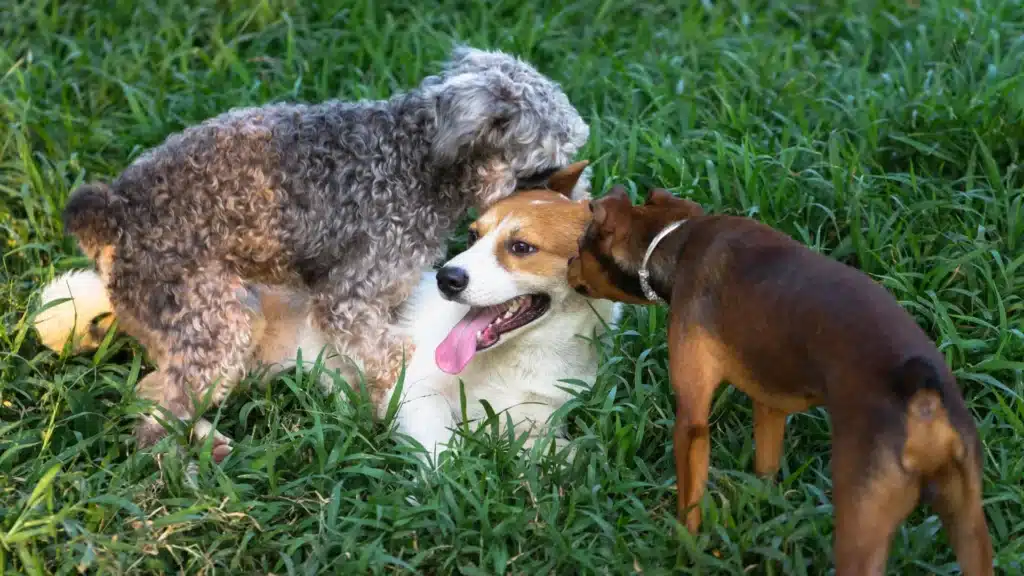Why does my dog hump
If you’ve ever caught your dog humping a pillow, another dog, or even your leg, you’re not alone. While it can be surprising (and sometimes awkward), humping is a completely normal behaviour for dogs. Many pet owners assume it’s always linked to mating, but the truth is, dogs hump for a variety of reasons—some of which have nothing to do with reproduction at all!
Whether your dog is a puppy or an adult, male or female, neutered or intact, humping can be a natural expression of excitement, stress, or even playfulness. But when does this Behavior become a problem? And what can you do about it?
In this post, we’ll explore the many reasons why dogs hump, when it’s a cause for concern, and how you can help manage or redirect this Behavior. Let’s dive in!

Common Reasons Why Dogs Hump
Humping (mounting) in dogs is not solely a reproductive behavior and it can come from a variety of physical, emotional, and social factors. Knowing the reasons behind this behaviour can help you determine if it is normal or if it requires further attention.
Sexual Behaviour
One of the most well known reasons dogs hump is sexual motivation. Both male and female dogs may mount each other during play or as part of mating behaviours. This is especially common in dogs that have not been spayed or neutered, as their hormones drive them to seek mating opportunities. However, even dogs that have been fixed may continue to hump out of habit or past learned behaviours.
Excitement & Overstimulation
Have you ever noticed your dog getting so excited that they don’t know what to do with themselves? Some dogs express enthusiasm by jumping, barking, or zooming around the house. Others might start humping, this often happens when a dog is overexicted, for example, when greeting guests, playing with a favourite toy, or during high-energy interactions.
Dominance & Social Behavior
Contrary to popular belief, humping is not always about dominance. Still, in some cases, it can be a way for a dog to establish social order. Dogs may mount other dogs to assert control or test boundaries, especially if they meet for the first time. However, this behaviour is often misinterpreted, and many dogs hump simply as part of normal canine interaction rather than an attempt to be “alpha.”
Play Behaviour
Puppies and younger dogs frequently hump each other as part of play. It’s normal for two dogs engaged in a game to take turns mounting each other. In these cases, humping is more about excitement and interaction rather than any deeper meaning. If both dogs seem comfortable and the behaviour isn’t excessive, it’s usually nothing to worry about.
Stress & Anxiety
Just like humans develop habits to cope with stress, like nail biting or pacing. Dogs can use humping as a self-soothing behaviour. If a dog is feeling anxious, overwhelmed, or uncertain, they may start humping as a way to release tension. This can happen when a dog is in a new environment, around unfamiliar people or animals, or experiencing a change in routine.
Medical Issues
In some cases, frequent humping can be a sign of an underlying medical condition. Urinary tract infections (UTIs), skin allergies, or other discomforts in the genital area can lead to excessive licking, mounting, or rubbing against objects. Suppose your dog suddenly starts humping more than usual or seems obsessed with the behaviour. In that case, it may be time for a vet checkup to rule out any health concerns.
Do All Dogs Hump? Understanding the Factors Behind This Behavior
If your dog humps from time to time, you might be wondering: Do all dogs do this? The short answer is no—not every dog humps, and some are more prone to it than others. Factors like gender, age, breed, and whether or not a dog has been spayed or neutered can all play a role in whether they develop this habit.
Humping isn’t just a male dog behaviour; it can be seen in females, too. Some dogs may only do it occasionally, while others might make it a regular part of their interactions with people, other dogs, or even objects.
Gender Differences in Humping
Many people associate humping with male dogs, but female dogs can and do hump as well. While male dogs might mount more frequently due to testosterone-driven behaviours, females can also exhibit this behaviour during play, excitement, or even communication with other dogs.
Spayed and neutered dogs can still hump, too! While fixing a dog often reduces sexually motivated behaviours, it doesn’t necessarily stop humping completely. This is because, as we discussed earlier, humping isn’t always about reproduction—it can be driven by emotions, social dynamics, or simple habits.
The Role of Neutering and Spaying
Many pet owners assume that getting their dog fixed will eliminate humping altogether. While spaying and neutering can reduce hormonally driven humping, it doesn’t always remove the behaviour entirely, especially if the dog has already learned to hump as a response to excitement or stress.
For some dogs, humping is a habit rather than a hormone-driven behaviour, so even after they’re fixed, they may continue to mount other dogs, people, or objects. The good news is that with training and redirection, humping can often be managed.
Does Breed or Personality Make a Difference?
Yes! Some dogs have more excitable or energetic personalities, making them more likely to engage in behaviours like humping, jumping, or mouthing. Certain breeds that are known for being highly social and playful—like Labrador Retrievers, Golden Retrievers, and Boxers—may be more prone to humping during playtime.
On the other hand, calmer or more independent breeds may not exhibit this Behavior as much. That said, any dog, regardless of breed, can develop humping habits based on their environment, training, and experiences.
Age and Developmental Factors
Puppies are often the biggest culprits when it comes to humping, but that doesn’t necessarily mean they’re displaying sexual Behavior. Young dogs explore the world through play, and mounting is one of many ways they learn about their bodies and social interactions.
As dogs grow older, some naturally stop humping on their own, while others continue the habit if it has been reinforced. Older dogs that suddenly start humping more than usual may be experiencing stress, a medical issue, or cognitive changes.
When Should You Be Concerned About Humping?
For the most part, humping is a normal dog behaviour that doesn’t require intervention. However, in some cases, it can become excessive, disruptive, or even signal an underlying health or behavioural issue.
Here are some signs that your dog’s humping may need closer attention:
Excessive or Obsessive Humping
If your dog humps constantly—whether it’s people, objects, or other dogs—it could be a sign that something is out of balance. Compulsive humping can be linked to:
High anxiety or stress (such as separation anxiety).
Lack of physical or mental stimulation leads to pent-up energy.
Compulsive behaviour issues, which may require professional training or medical intervention.
If your dog seems unable to stop, even after redirection or training, it may be time to consult a veterinarian or animal behaviourist.
Humping That Causes Discomfort or Conflict
While playful humping is common in dog interactions, it can sometimes lead to tension or fights. If your dog mounts other dogs at the park and those dogs react negatively (growling, snapping, or avoiding your dog), it’s important to intervene.
If your dog humps people and it makes guests uncomfortable. In that case, it’s a behaviour that should be addressed through training and redirection.
Sudden Changes in Humping Behavior
If your dog suddenly starts humping more than usual, there may be an underlying health issue. Some medical problems that can cause increased humping include:
- Urinary tract infections (UTIs)
- Skin allergies or irritation
- Hormonal imbalances
- Neurological disorders
If your dog seems uncomfortable, frequently licks its genital area, or has other changes in behaviour, seeing a vet is a good idea to rule out any health concerns.
Humping That Interferes with Daily Life
Suppose your dog’s humping is so frequent that it disrupts their ability to focus on training, play, or relaxation. In that case, it’s time to take action. Dogs that can’t seem to control their humping might need more exercise, enrichment, or structured training to help redirect their energy in a positive way.

How to Manage and Reduce Humping in Dogs
If your dog’s humping is getting out of hand, don’t worry—you’re not alone, and there are plenty of ways to address it. While sometimes mounting is normal, too much humping can be disruptive, embarrassing, or even a sign of underlying stress or medical issues.
The good news? With the right approach, you can help your dog redirect their energy and reduce unwanted humping Behavior. Let’s explore some of the best strategies to manage and prevent excessive humping.
Training & Redirection: Teaching Your Dog Better Habits
One of the most effective ways is training to prevent humping, mainly when it’s triggered by excitement or overstimulation. Here’s how you can help your dog break the habit:
- Use the “Leave It” or “Off” Command
Teaching a firm “leave it” or “off” command can help stop humping in the moment. If your dog starts mounting someone or something, calmly but firmly say the command, redirect their attention, and reward them when they obey. - Distract with a Toy or Game
If you notice your dog getting overly excited and gearing up to hump, redirect their energy before it starts. Toss a ball, give them a chew toy, or engage them in a quick training session to shift their focus. - Remove the Opportunity
If your dog consistently humps a particular object (like a pillow or stuffed animal), consider removing it from their environment. Over time, this can help break the habit. - Positive Reinforcement Works Best
Never punish your dog for humping—this can create confusion and anxiety, making the problem worse. Instead, focus on rewarding them when they make good choices, such as sitting calmly instead of mounting.
Neutering/Spaying: Will It Help?
One of the first questions many pet owners ask is: Will neutering or spaying stop my dog from humping?
The answer is: It depends.
- Spaying and neutering can reduce hormone-driven humping, especially in younger dogs who haven’t yet formed strong humping habits.
However, it won’t necessarily stop humping entirely, especially if your dog humps due to excitement, stress, or learned Behavior. If humping continues after the procedure, additional training and redirection will be needed.
If you’re unsure whether spaying or neutering is the right choice for your dog, consult your vet to discuss the benefits and potential behavioural changes.
Exercise & Mental Stimulation: Burning Off Excess Energy
One of the simplest ways to reduce humping is to ensure your dog is getting enough physical and mental stimulation. Many dogs hump because they have pent-up energy or boredom, so increasing their activity level can work wonders.
- Daily Walks & Playtime – A tired dog is a happy dog! Make sure your pup gets regular exercise tailored to their breed and energy level.
- Puzzle Toys & Training Games – Mental stimulation is as important as physical activity. Puzzle feeders, snuffle mats, and obedience training can help engage your dog’s brain.
- Structured Socialization – If your dog humps excessively during playdates, make sure they’re socializing with well-mannered dogs who can help teach appropriate Behavior.
Socialization & Setting Boundaries
If your dog tends to hump other dogs, teaching proper social manners is important.
- Monitor Playtime – If your dog humps excessively during play, gently interrupt and redirect them before it becomes a problem.
- Teach a “Calm Down” Cue – Training your dog to settle on command can help prevent overexcitement from turning into humping.
- Respect Other Dogs’ Boundaries – If another dog seems uncomfortable or defensive when your pup starts humping, step in and redirect before it escalates.
- Dogs learn a lot from their interactions with other dogs, so balanced, positive social experiences can help teach them appropriate play behaviour.
Medical Checkups: Ruling Out Underlying Issues
If your dog’s humping has suddenly increased or seems compulsive, it’s always a good idea to rule out medical issues. A trip to the vet can help identify if there’s an underlying cause, such as:
- Urinary tract infections (UTIs)
- Skin allergies or irritation
- Hormonal imbalances
- Pain or discomfort in the genital area
If your dog licks themselves excessively, seems uncomfortable, or has other unusual symptoms, a veterinary exam is recommended. Treating the root cause can often resolve excessive humping Behavior.
At the end of the day, humping is a natural behaviour—but when it becomes excessive or disruptive, it’s important to address it in a positive way.
To help your dog stop humping, first understand why they do it. Use training and redirection to guide their behavior. Make sure they get enough exercise. Lastly, check with a vet to rule out any medical issues. These steps will help your dog learn better habits and have fun, respectful social interactions.
Remember, patience is key!
